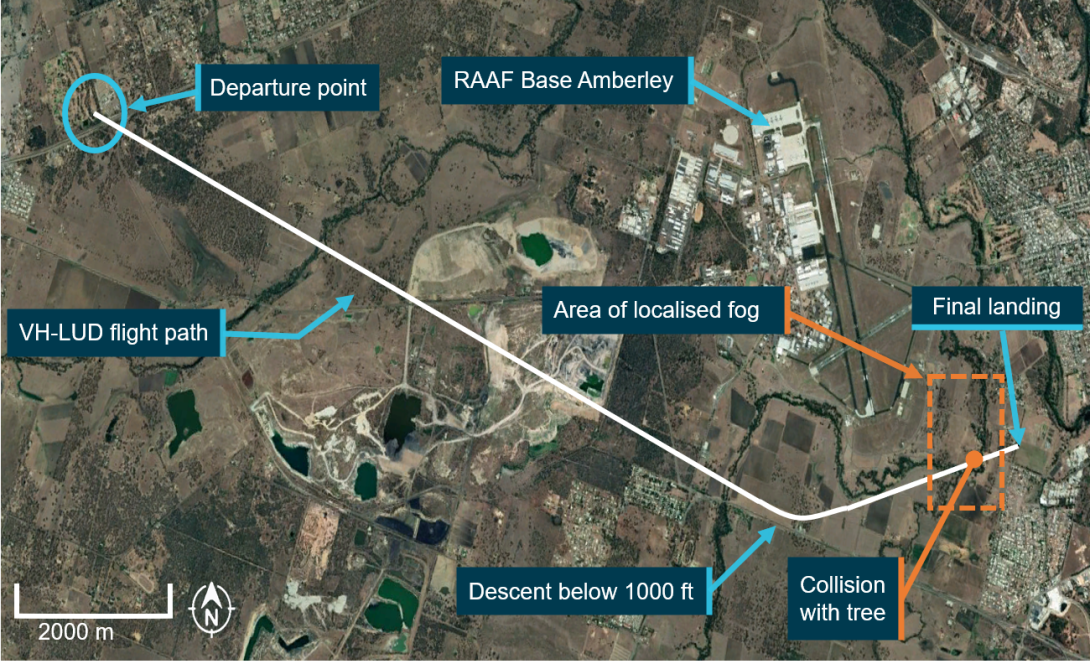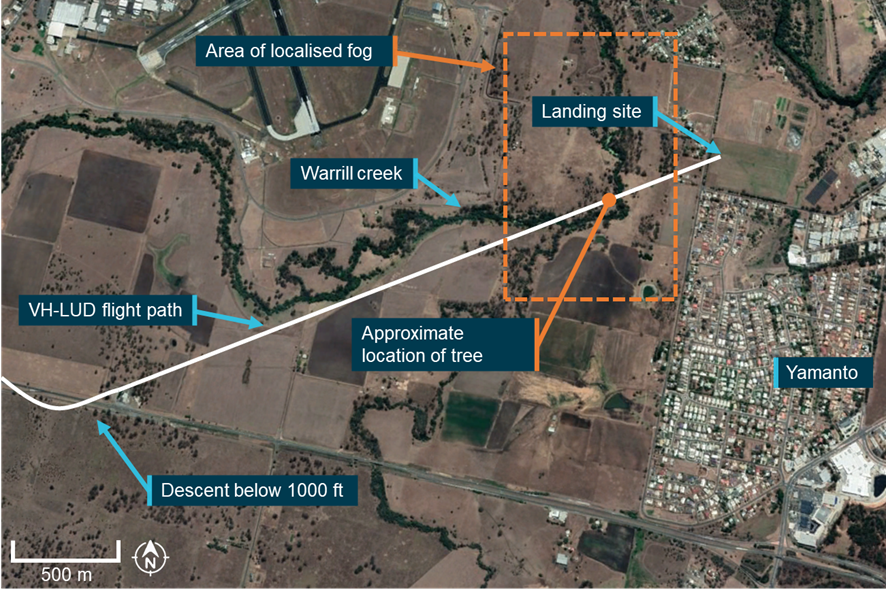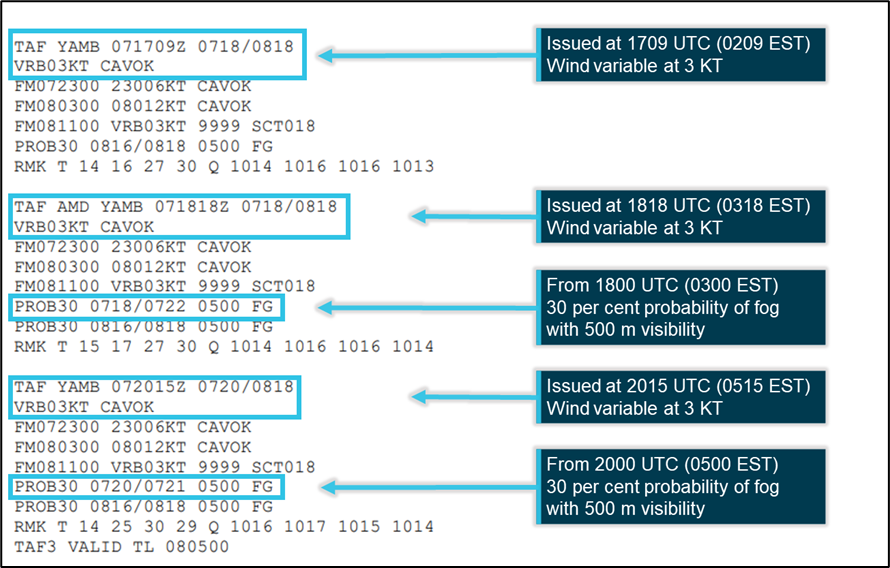Executive summary
What happened
On 8 October 2021, a Kavanagh Balloons E-240 balloon, registered VH-LUD and operated by Floating Images Aust. Pty Ltd was conducting a morning scenic flight about 45 km south‑west of Brisbane, Queensland. On board was a pilot and 9 passengers. About 55 minutes into the flight, the pilot commenced a descent to locate a suitable landing area. During the descent, the balloon entered an area of localised fog where visibility reduced to 10 m.
The pilot continued the descent into the fog until a tree was observed in the path of the balloon. The pilot attempted to avoid the tree by initiating a climb, but the balloon collided with, and came to rest on the side of the tree, damaging the lower part of the balloon envelope. The pilot subsequently climbed the balloon off the tree and above the fog. The flight continued to an uneventful landing in a nearby paddock that was clear of fog. There were no injuries.
What the ATSB found
The ATSB found that, contrary to the visual flight rules visibility requirement, the pilot entered an area of reduced visibility in which the visibility was 10 m. This did not allow sufficient time to complete an avoidance manoeuvre when an obstacle was observed, as a result the balloon collided with a tree and the balloon envelope was damaged.
Safety message
In some circumstances, balloons are permitted to fly in significantly lower visibility than other types of aircraft. While this is mainly due to their inherently low flight speed, it also considerably reduces the available time to see obstacles. Additionally, as balloons can only manoeuvre vertically and significant time may be required to transition from a descent to a climb, they have limited capability to avoid obstacles.
Therefore, to reduce the collision risk if a balloon enters an area of visibility less than that permitted by the visual flight rules, pilots should ensure that an immediate recovery is commenced.
The investigation
| Decisions regarding whether to conduct an investigation, and the scope of an investigation, are based on many factors, including the level of safety benefit likely to be obtained from an investigation. For this occurrence, a limited-scope investigation was conducted in order to produce a short investigation report, and allow for greater industry awareness of findings that affect safety and potential learning opportunities. |
The occurrence
On 8 October 2021, the pilot of a Kavanagh Balloons E-240 balloon, registered VH-LUD, was preparing for a morning scenic charter flight for 9 passengers from a location 45 km south‑west of Brisbane, Queensland. The pilot reported releasing a small helium balloon from the Ipswich Visitor Information Centre, located about 6 km to the east of RAAF Base Amberley (Figure 1), at 0425 Eastern Standard Time,[1] to observe wind speed and direction. The pilot also checked the wind observations recorded at the nearby RAAF Base, which were variable[2] at 3 knots.
Following an assessment, via the observation balloon, that the wind was from the west‑north‑west, the pilot planned the flight to commence at Rosewood Golf Club with an intent to track south-east, to the south of RAAF Base Amberley, and continue towards Yamanto (Figure 1). The pilot commented that there was no fog present at the departure time.
The 9 passengers arrived at the Ipswich Visitor Information Centre at about 0425 and they were taken to Rosewood Golf Club. The passengers were briefed on the 3 stages of balloon flying: inflation, flight, and landing. The pilot then inflated the balloon, and the passengers were boarded.
Although the pilot planned the flight in non-controlled Class G airspace[3] around RAAF Base Amberley, they made a telephone call to RAAF Amberley air traffic control and left a message on their answering machine with details of the balloon flight. The pilot reported that this was in case RAAF Amberley airspace became active during the period of the balloon flight and the airspace reverted to military Class C airspace[4] (see the section titled Airspace).
The balloon took off at around 0520 and tracked towards the east-south-east as expected from the wind observations. The pilot reported clear skies with some localised fog present to the south‑east of the RAAF base. The pilot estimated the fog to be from the surface to a height of 500 ft.
Figure 1: Flight path of VH-LUD

Source: Google Earth, annotated by the ATSB
After about 55 minutes of flight time the pilot commenced a descent to visually identify and select a suitable landing area. As the balloon descended below 1,000 ft the wind backed[5] to a south‑westerly. As a consequence of that wind change, the balloon began tracking north-east towards the previously‑identified fog bank (Figure 2).
The pilot approached the fog expecting to be able to maintain visual requirements for landing. However, upon entering the fog, the pilot recalled observing that it was significantly thicker than they expected or had flown in before with visibility of about 10 m. The pilot continued to descend at approximately 200 feet per minute into the fog until they sighted a tree directly ahead of them. In response, the pilot immediately commenced burning on all 3 burners to arrest the descent and transition to a climb, but the balloon collided with the tree at a speed of about 4 knots. The balloon came to rest on the side of the tree at a height of about 60 ft above the ground.
Figure 2: Descent of VH-LUD to Yamanto

Source: Google Earth, annotated by the ATSB
The pilot continued operating the burners and the balloon commenced a climb away from the tree. The pilot climbed the balloon until they were out of the fog and conducted an uneventful landing in a nearby paddock, clear of the fog. There were no injuries to the pilot or passengers, however multiple sections of the lower portion of the balloon envelope required repair or replacement due to damage by tree branches. The balloon returned to service 7 days later.
Context
Pilot experience
The pilot held a Civil Aviation Safety Authority (CASA) Commercial Pilot Licence (Balloon) that was issued in January 1995. At the time of the occurrence the pilot had accrued a total flying time of 2,904 hours with approximately 2,000 hours on type. The pilot held a current CASA class 2 aviation medical certificate.
The pilot also held a CASA Maintenance Authority to conduct maintenance on the Kavanagh balloon.
Balloon information
VH-LUD was a Kavanagh Balloons E-240 manned free balloon manufactured as serial number E24-527 in 2016 by Kavanagh Balloons Australia Pty Ltd. The E‑240 balloon has an envelope capacity of 240,000 cubic feet and a maximum take-off weight of 2,000 kg. It is powered by three burners connected to two independent fuel systems. At the time of the occurrence VH‑LUD had accumulated a total time of 492.8 hours in service.
Flight conditions
The pilot obtained weather observations, noting isolated fog was forecast and that the wind was variable at 3 knots. The pilot also commented that if there was visible fog at their nearby residence prior to departure, as a general practice they would reschedule the flight.
An Amberley terminal area forecast (TAF) was issued at 0209 EST for the 24 hours from 0300 with an amendment issued at 0318 (Figure 3). A further TAF was issued at 0515, about the same time the balloon took off. All 3 forecasts predicted variable winds at 3 knots and a 30% probability of fog, in which visibility would reduce to 500 m.
Figure 3: RAAF Amberley terminal area forecast

Source: Airservices Australia, annotated by the ATSB
Airspace requirements
RAAF Base Amberley is surrounded by Class G non-controlled airspace, which allows aircraft to operate without air traffic control (ATC) permission. This airspace becomes military Class C when the air traffic control tower is active. Permission is required from Amberley ATC to operate in Class C airspace. At the time of the flight, the air traffic control tower was not active, therefore, Class G airspace procedures applied.
The pilot reported telephoning RAAF Base Amberley air traffic control and leaving a message on their answering machine with the balloon flight details. The pilot had conducted this process for a number of years. The pilot also reported monitoring the Amberley common traffic advisory frequency for traffic during the flight.
In Class G airspace, the required visibility for a balloon operating below 1,500 ft above ground level and clear of cloud, is 5,000 m. However, a balloon operating below 500 ft above ground level and beyond 10 NM of an aerodrome with an approved instrument approach procedure only requires 100 m visibility.
On this occasion, as this flight was conducted within 10 NM of RAAF Base Amberley, an aerodrome having approved instrument approach procedures, the balloon was required to maintain at least 5,000 m visibility and remain clear of cloud irrespective of its operating height.
Balloon performance
The pilot reported that at the time the tree was observed the balloon was descending at a rate of about 200 feet per minute and was flying at a velocity of about 4 knots. As soon as the pilot saw the tree, they commenced burning on all three burners.
The pilot stated the balloon took 20-30 seconds to arrest the descent and commence climbing. The pilot reported the balloon ‘settling’ on the side of the tree in a slow speed collision.
Damage to balloon
The balloon envelope consisted of a total of 460 sewn panels in a combination of four differing sizes. A total of 19 panels were damaged during the occurrence. These panels were either repaired or replaced by the operator in accordance with the Kavanagh Balloons maintenance manual.
Safety analysis
The RAAF Base Amberley TAF listed a 30% probability that fog would be present in the area, in which visibility would be 500 m. The pilot reported that during flight preparation there was no fog present. During the flight, fog was observed in a localised area to the south-east of RAAF Base Amberley.
The flight was conducted in Class G airspace within 10 NM of the RAAF Base. Due to the RAAF Base having an approved instrument approach procedure, the balloon operating under the visual flight rules was required to remain clear of cloud and maintain a minimum visibility of 5,000 m.
The pilot commenced a descent with the intention of locating a suitable landing area. During this descent, the wind backed, and the balloon began tracking towards the area of localised fog. Instead of remaining above the localised fog and descending in the clear air beyond, the pilot continued the descent and entered the fog believing that adequate visibility would exist for the landing. The visibility subsequently reduced to 10 m.
The pilot observed a tree, and in an attempt to prevent a collision, lit the burners to transition to a climb. However, due to the 20-30 seconds required before the descent could be arrested and a climb commence, there was insufficient time for the tree to be avoided due to the limited visibility. Given the climb performance of the balloon, even if the circumstances around the airspace allowed for the flight to be conducted in visibility conditions down to 100 m, the collision would still have occurred.
After the collision, the pilot climbed the balloon off the tree and up into clear air. The balloon was then flown to the edge of the localised fog and an uneventful landing was carried out.
Findings
|
ATSB investigation report findings focus on safety factors (that is, events and conditions that increase risk). Safety factors include ‘contributing factors’ and ‘other factors that increased risk’ (that is, factors that did not meet the definition of a contributing factor for this occurrence but were still considered important to include in the report for the purpose of increasing awareness and enhancing safety). In addition, ‘other findings’ may be included to provide important information about topics other than safety factors. These findings should not be read as apportioning blame or liability to any particular organisation or individual. |
From the evidence available, the following finding is made with respect to the collision with terrain involving Kavanagh E-240 Balloon, VH-LUD, at Yamanto, Queensland.
Contributing factors
- Contrary to the visibility requirement for visual flight rules flight, the pilot entered an area of fog that did not permit sufficient time to see and avoid obstacles. As a result, the balloon collided with a tree, damaging the balloon's envelope.
Sources and submissions
Sources of information
The sources of information during the investigation included:
- the pilot of VH-LUD
- Civil Aviation Safety Authority
- RAAF Base Amberley air traffic control.
Submissions
Under section 26 of the Transport Safety Investigation Act 2003, the ATSB may provide a draft report, on a confidential basis, to any person whom the ATSB considers appropriate. That section allows a person receiving a draft report to make submissions to the ATSB about the draft report.
A draft of this report was provided to the following directly involved parties:
- the pilot of VH-LUD
- Civil Aviation Safety Authority.
Submissions were received from:
- the pilot of VH-LUD
- Civil Aviation Safety Authority
The submissions from those parties were reviewed however, they did not result in any amendment to the text of the draft report.
Purpose of safety investigationsThe objective of a safety investigation is to enhance transport safety. This is done through:
It is not a function of the ATSB to apportion blame or provide a means for determining liability. At the same time, an investigation report must include factual material of sufficient weight to support the analysis and findings. At all times the ATSB endeavours to balance the use of material that could imply adverse comment with the need to properly explain what happened, and why, in a fair and unbiased manner. The ATSB does not investigate for the purpose of taking administrative, regulatory or criminal action. TerminologyAn explanation of terminology used in ATSB investigation reports is available here. This includes terms such as occurrence, contributing factor, other factor that increased risk, and safety issue. Publishing informationReleased in accordance with section 25 of the Transport Safety Investigation Act 2003 Published by: Australian Transport Safety Bureau © Commonwealth of Australia 2022
Ownership of intellectual property rights in this publication Unless otherwise noted, copyright (and any other intellectual property rights, if any) in this report publication is owned by the Commonwealth of Australia. Creative Commons licence With the exception of the Coat of Arms, ATSB logo, and photos and graphics in which a third party holds copyright, this publication is licensed under a Creative Commons Attribution 3.0 Australia licence. Creative Commons Attribution 3.0 Australia Licence is a standard form licence agreement that allows you to copy, distribute, transmit and adapt this publication provided that you attribute the work. The ATSB’s preference is that you attribute this publication (and any material sourced from it) using the following wording: Source: Australian Transport Safety Bureau Copyright in material obtained from other agencies, private individuals or organisations, belongs to those agencies, individuals or organisations. Where you wish to use their material, you will need to contact them directly. |
[1] Eastern Standard Time (EST): Coordinated Universal Time (UTC) + 10 hours
[2] Variable: used when the forecasting of mean wind direction is not possible. Usually due to low wind velocity.
[3] Class G: This airspace is not subject to air traffic control (ATC). Both instrument flight rules and visual flight rules aircraft are permitted and neither require ATC clearance.
[4] Class C airspace: Controlled airspace surrounding major airports. Both instrument flight rules and visual flight rules aircraft are permitted, but pilots must obtain a clearance to operate and maintain continuous radio contact with air traffic control.
[5] Backed: A counter‑clockwise shift in the wind direction.


